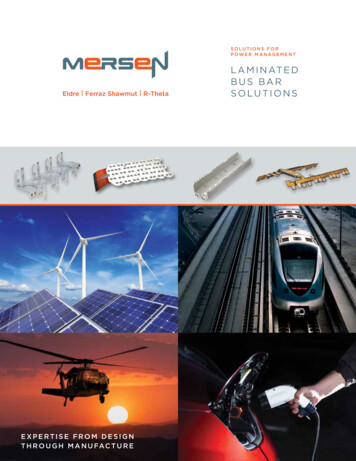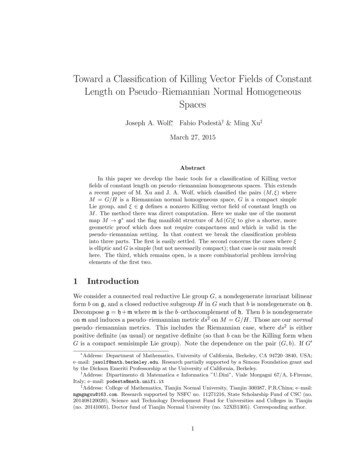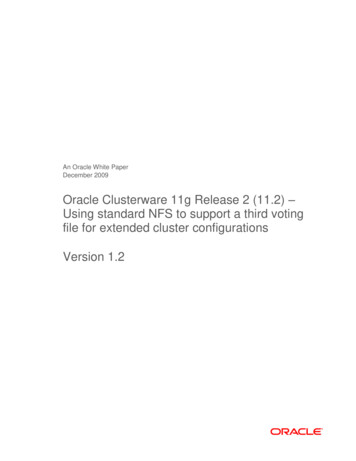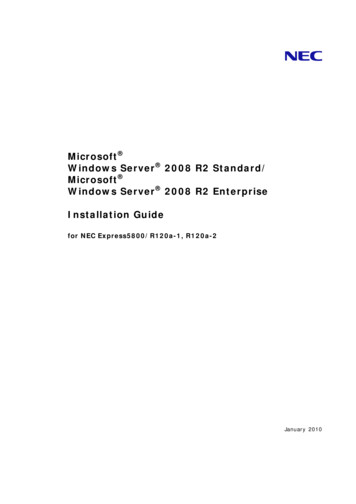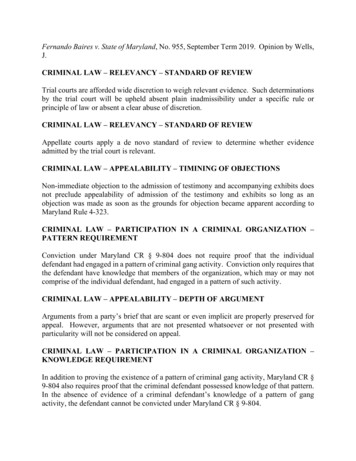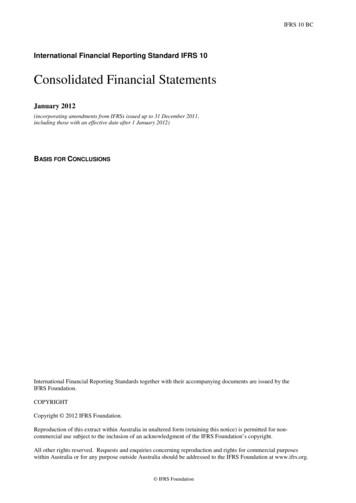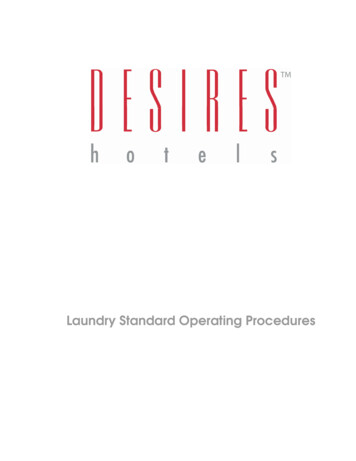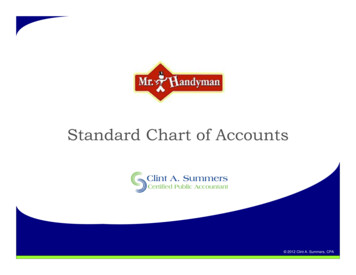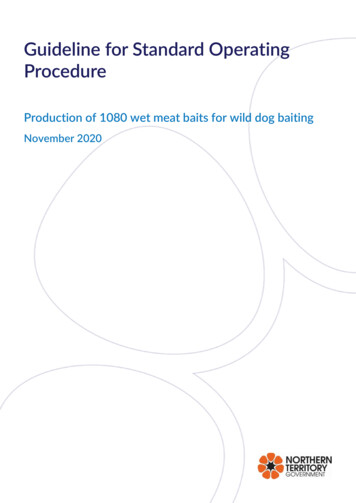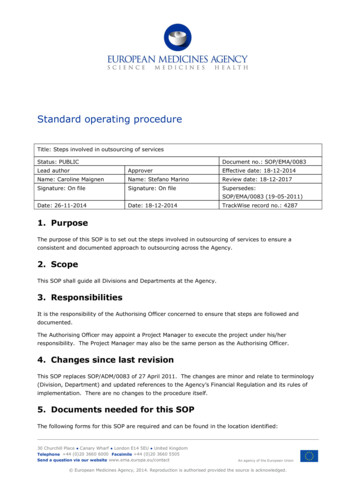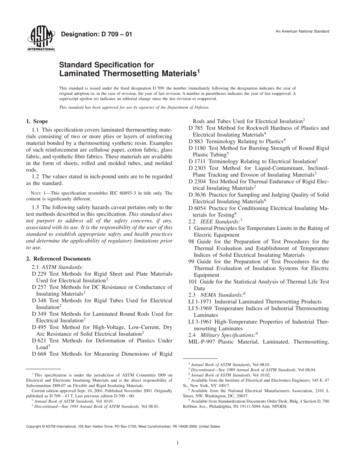
Transcription
An American National StandardDesignation: D 709 – 01Standard Specification forLaminated Thermosetting Materials1This standard is issued under the fixed designation D 709; the number immediately following the designation indicates the year oforiginal adoption or, in the case of revision, the year of last revision. A number in parentheses indicates the year of last reapproval. Asuperscript epsilon (e) indicates an editorial change since the last revision or reapproval.This standard has been approved for use by agencies of the Department of Defense.Rods and Tubes Used for Electrical Insulation2D 785 Test Method for Rockwell Hardness of Plastics andElectrical Insulating Materials4D 883 Terminology Relating to Plastics4D 1180 Test Method for Bursting Strength of Round RigidPlastic Tubing5D 1711 Terminology Relating to Electrical Insulation2D 2303 Test Method for Liquid-Contaminant, InclinedPlane Tracking and Erosion of Insulating Materials2D 2304 Test Method for Thermal Endurance of Rigid Electrical Insulating Materials2D 3636 Practice for Sampling and Judging Quality of SolidElectrical Insulating Materials6D 6054 Practice for Conditioning Electrical Insulating Materials for Testing62.2 IEEE Standards:71 General Principles for Temperature Limits in the Rating ofElectric Equipment98 Guide for the Preparation of Test Procedures for theThermal Evaluation and Establishment of TemperatureIndices of Solid Electrical Insulating Materials99 Guide for the Preparation of Test Procedures for theThermal Evaluation of Insulation Systems for ElectricEquipment101 Guide for the Statistical Analysis of Thermal Life TestData2.3 NEMA Standards:8LI 1-1971 Industrial Laminated Thermosetting ProductsLI 5-1969 Temperature Indices of Industrial ThermosettingLaminatesLI 3-1961 High-Temperature Properties of Industrial Thermosetting Laminates2.4 Military Specifications:9MIL-P-997 Plastic Material, Laminated, Thermosetting,1. Scope1.1 This specification covers laminated thermosetting materials consisting of two or more plies or layers of reinforcingmaterial bonded by a thermosetting synthetic resin. Examplesof such reinforcement are cellulose paper, cotton fabric, glassfabric, and synthetic fiber fabrics. These materials are availablein the form of sheets, rolled and molded tubes, and moldedrods.1.2 The values stated in inch-pound units are to be regardedas the standard.NOTE 1—This specification resembles IEC 60893-3 in title only. Thecontent is significantly different.1.3 The following safety hazards caveat pertains only to thetest methods described in this specification. This standard doesnot purport to address all of the safety concerns, if any,associated with its use. It is the responsibility of the user of thisstandard to establish appropriate safety and health practicesand determine the applicability of regulatory limitations priorto use.2. Referenced Documents2.1 ASTM Standards:D 229 Test Methods for Rigid Sheet and Plate MaterialsUsed for Electrical Insulation2D 257 Test Methods for DC Resistance or Conductance ofInsulating Materials2D 348 Test Methods for Rigid Tubes Used for ElectricalInsulation2D 349 Test Methods for Laminated Round Rods Used forElectrical Insulation2D 495 Test Method for High-Voltage, Low-Current, DryArc Resistance of Solid Electrical Insulation2D 621 Test Methods for Deformation of Plastics UnderLoad3D 668 Test Methods for Measuring Dimensions of Rigid4Annual Book of ASTM Standards, Vol 08.01.Discontinued—See 1989 Annual Book of ASTM Standards, Vol 08.04.Annual Book of ASTM Standards, Vol 10.02.7Available from the Institute of Electrical and Electronics Engineers, 345 E. 47St., New York, NY 10017.8Available from the National Electrical Manufacturers Association, 2101 LStreet, NW, Washington, DC, 20037.9Available from Standardization Documents Order Desk, Bldg. 4 Section D, 700Robbins Ave., Philadelphia, PA 19111-5094 Attn: NPODS.561This specification is under the jurisdiction of ASTM Committee D09 onElectrical and Electronic Insulating Materials and is the direct responsibility ofSubcommittee D09.07 on Flexible and Rigid Insulating Materials.Current edition approved Sept. 10, 2001. Published November 2001. Originallypublished as D 709 – 43 T. Last previous edition D 709 – 00.2Annual Book of ASTM Standards, Vol 10.01.3Discontinued—See 1993 Annual Book of ASTM Standards, Vol 08.01.Copyright ASTM International, 100 Barr Harbor Drive, PO Box C700, West Conshohocken, PA 19428-2959, United States.1
D 709 – 01Electric Insulation, Sheets, Glass Cloth, Silicone ResinMIL-P-15035 Plastic Sheet, Laminated, Thermosetting,Cotton-Fabric-Base, Phenolic-ResinMIL-P-15037 Plastic Sheet, Laminated, Thermosetting,Glass-Cloth, Melamine-ResinMIL-P-15047 Plastic Material, Laminated ThermosettingSheets, Nylon Fabric Base, Phenolic-ResinMIL-P-18177 Plastic Sheet, Laminated, Thermosetting,Glass Fibre Base, Epoxy-ResinMIL-P-22324 Plastic Sheet, Thermosetting, Paper-Base,Epoxy-Resin2.5 Federal Specifications:L-P-513 Plastic Sheet and Insulation Sheet, Electrical(Laminated, Thermosetting, Paper-Base, Phenolic-Resin)9L-P-509 Plastic Sheet, Rod and Tube, Laminated Thermosetting92.6 IEC Standard:Publication 60893-3 Specification for Industrial LaminatedSheets Based on Thermosetting Resins for ElectricalPurposes10Machined rods, manufactured from certain grades of sheet material, arenot covered by this specification. In rods machined from sheets, thelaminations are parallel chords of a circular cross-section. In general, theproperties of these rods conform to those of the grade of sheet stock fromwhich they are cut. This type of rod may be low in flexural strength whenstress is applied perpendicular to the lamination.NOTE 5—Molded shapes are composed of impregnated sheet materialscut into various sizes and shapes to fit the contours of a mold, and moldedunder heat and pressure. In special cases some macerated material is usedin combination with impregnated sheet materials, depending upon thedesign of the piece. The requirements of this specification, particularlywith regard to mechanical properties, cannot be considered as applying tomolded shapes, except for rectangular and square tubes, since suchproperties will depend to a considerable extent upon the design of thepiece.6. General Requirements6.1 Materials and Workmanship—Laminated material shallbe uniform in quality. It shall be free of blisters, wrinkles, orcracks and shall be reasonably free of other small defects suchas scratches, heat marks, etc., as defined in Terminology D 883.Tubes of any grade having wall thickness greater than 1 2 in.(13 mm) and molded paperbase rods (Grades XX and XXX)having diameters greater than 1 in. (25 mm) may show checksor cracks between the laminations on machined or sawededges.6.2 Finish and Color— Requirements for finish (Note 6)and color (Note 7) shall be as specified by the purchaser in thecontract or order.3. Terminology3.1 Definitions—For definitions of terms used in this specification, refer to Terminologies D 883 or D 1711.4. Types and Grades4.1 Laminated materials covered by this specification areclassified in accordance with the types of reinforcement used intheir manufacture, and the electrical, mechanical, and heatresisting characteristics of the finished products (Note 2).NOTE 6—The various forms and grades of laminated thermosettingmaterial are available in the finishes shown in Table 3.NOTE 7—The various types and grades of laminated thermosettingmaterial are available in the colors shown in Table 4. Where MIL-Pspecifications are involved, natural color only shall be supplied.NOTE 2—Further descriptive information regarding these various typesand grades of laminated thermosetting materials is given in Table 1 andAppendix X1-Appendix X3. Appendix X3 also includes tables coveringengineering information on other properties of the various grades oflaminated thermosetting products that are not included in these specification requirements.6.3 Warp or Twist— The warp or twist shall not exceed thevalues prescribed in Table 5.6.4 Punching Properties—The grades of material differ intheir suitability for punching, but thin pieces of any of thegrades may be punched in simple shapes, provided goodpunching practice is used, including sharp, close-clearancedies, proper stripper plates, and proper heating conditions.When using good punching practice as outlined below, thevarious grades shall punch satisfactorily in thickness up to andincluding the maximum limits as prescribed in Table 6. Wherepunching properties better than those listed in Table 6 arerequired for particular parts, this shall be subject to agreementbetween the purchaser and the manufacturer. In good punchingpractice the edges of the piece shall be no closer to the edge ofthe strip than twice the thickness of the sheet, the holes shall beno smaller in diameter than the thickness of the sheet nor havesquare corners, and the distance between the holes or betweenthe holes and the edge of the piece shall be no less than thethickness of the sheet. For thicker materials, depending uponthe grade, heating the material to a temperature of 120 to140 C (approximately 15 min for material 1 8 in. (3 mm) inthickness) is generally necessary for best punching results,although in Grade XP or XPC this may make the material toosoft. In this case, better results may be obtained by heating atlower temperatures or for a shorter time. If more than 2 minelapse between the time the strip leaves the heating mediumand the last piece is punched, results will be poor.5. Forms5.1 Laminated thermosetting materials are available in fourforms: sheets, tubes (Note 3), rods (Note 4), and molded shapes(Note 5), as indicated in Table 2. This specification covers thematerial in three forms: sheets, tubes of two classes (rolled andmolded), and molded rods. The classes of tubes desired shall bespecified by the purchaser in the contract or order. In caseswhere the purchaser desires a particular class of molded rod heshould so specify.NOTE 3—Tubes are made of laminations of fibrous sheet impregnatedmaterial, rolled upon mandrels under tension or between heated pressurerolls, or both. They are of two classes, rolled and molded. Rolled tubes areoven-baked after rolling on the mandrels. Molded tubes are cured in moldsunder heat and pressure.NOTE 4—Molded rods are composed of laminations of impregnatedsheet material molded in cylindrical molds under heat and pressure, andthen ground to size. Molded rods are of two classes made by winding theimpregnated sheet convolutely before molding or by forming strips in themolding operation.10Available from American National Standards Institute, 11 W. 42nd St., 13thFloor, New York, NY 10036.2
D 709 – 01TABLE 1 Types and Grades of Laminated Thermosetting MaterialsD 709GradeDesignationMIL-P and LP GradeDesignationADescriptionType I—Cellulose Paper-Base Phenolic Resin (Unless S-3.L-P-513, Type PBG.L-P-513, Type PBEL-P-513, Type PBE-PL-P-513, Type PBE-P.MIL-P-22324, Type PEE.mechanicalmechanical; hot-punching stockmechanical; cold-punching and cold-shearing stockelectrical and mechanicalelectrical and mechanical; hot-punching stockelectrical and high humidityelectrical and high humidity; hot-punching stockpunchable at lower temperature than Grade XXXPpaper-base, flame-resistant, similar to Grade XPpaper-base, flame-resistant, similar to Grade XXXPflame-resistant, epoxy resin; electrical and mechanicalmechanical; engraving stock usually melamine bindermechanical; engraving stock usually melamine bindermechanical; engraving stock usually melamine binderType II—Cellulose Fabric-Base Phenolic hanical and electricalmechanical; fine machiningmechanical and electrical; fine machiningType IV—Glass-BaseG-3G-5.G-7MIL-P-997, Type GSGG-9MIL-P-15037, Type GMEG-10MIL-P-18177, Type GEEG-11MIL-P-18177, Type GEBFR-4MIL-P-18177, Type GEEFR-5MIL-P-18177, Type GEBcontinuous filament-type glass cloth; phenolic resin, general purposecontinuous filament-type glass cloth, melamine binder; general purpose;good arc and flame resistancecontinuous filament-type glass cloth, silicone resin binder; good mechanicalstrength, heat and arc resistance; low dielectric losses and high insulationresistance under humid conditionscontinuous filament-glass cloth, melamine binder. Superior to Grade G-5under wet conditions, good arc and flame resistancecontinuous filament-type glass cloth, epoxy resin binder; high mechanicalstrength good insulation resistance, dielectric loss, and dielectric strengthunder dry and humid conditionscontinuous filament-type glass cloth, heat-resistant epoxy binder; propertiessimilar to Grade G-10 but higher flexural strength retained at elevatedtemperaturescontinuous filament-glass cloth with a flame-resistant epoxy resin binder;properties similar to G-10continuous filament-glass cloth with a heat- and flame-resistant epoxy resinbinder; properties similar to G11Glass mat with polyester resin binder, for general purpose, flame resistanceand tracking resistanceGlass mat with polyester resin binder, for general purpose, flame resistanceand tracking resistanceGPO-1, GPO-2, and GPO-3GPO-1P, GPO-2P, and GPO-3PType V—Nylon-BaseN-1MIL-P-15047, Type NPGnylon cloth-base, phenolic resin binder; excellent electrical properties underhigh humidity; good impactType VI—Composite-Base LaminatesCEM-1CEM-3.cellulose paper core, glass surfaces, flame-resistant resin (see X1.28)non-woven glass core, glass surfaces, flame-resistant resin (see X1.29)AThe MIL-P and LP-513 designations apply only to sheet materials. LP-509 applies to sheet and tube material. Revisions of this specification are designated by suffixletters added to the MIL-P or LP Specification number, A for the first revision, B for the second, etc. Reference should accordingly be made to the latest edition
Designation: D 709 – 01 An American National Standard Standard Specification for Laminated Thermosetting Materials1 This standard is issued under the fixed designation D 709; the number immediately following the designation indicates the year of original adoption or, in the case of revision, the year of last revision. A number in parentheses indicates the year of last reapproval. AFile Size: 253KBPage Count: 34

